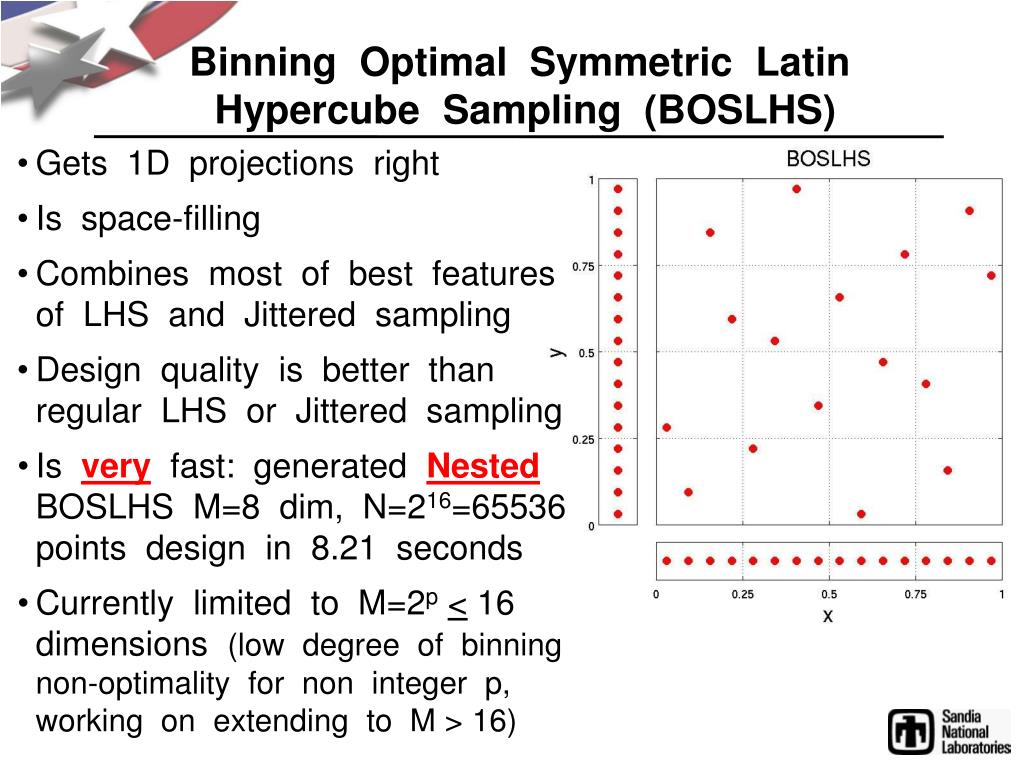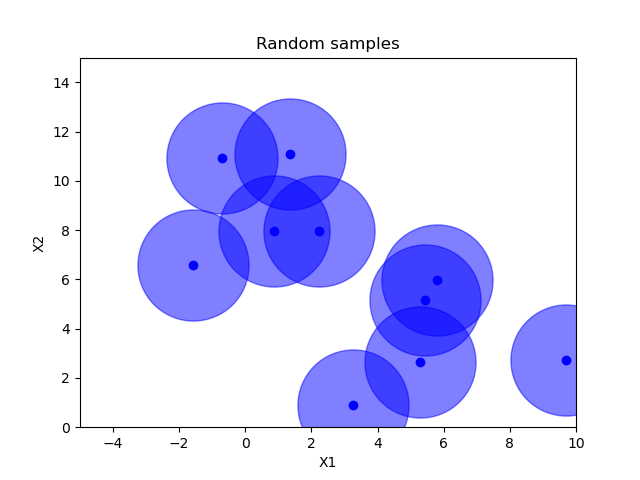

- Latin hypercube sampling python how to#
- Latin hypercube sampling python install#
- Latin hypercube sampling python code#
- Latin hypercube sampling python free#
George Karniadakis from 2018 to 2020, supported by PhILMs.ĭeepXDE is currently maintained by Lu Group at University of Pennsylvania with major contributions coming from several talented individuals in various forms and means. If you know the answer to any question in the "Issues", you are welcomed to answer.ĭeepXDE was originally developed by Lu Lu at Brown University under the supervision of Prof.
Latin hypercube sampling python how to#
To get help on how to use DeepXDE or its functionalities, you can as well open an issue.

Latin hypercube sampling python free#
If you made improvements to DeepXDE, fixed a bug, or had a new example, feel free to send us a pull-request. To submit an enhancement suggestion for DeepXDE, including completely new features and minor improvements to existing functionality, let us know by opening an issue.

To report a bug, simply open an issue in the GitHub "Issues" section. Contributing to DeepXDEįirst off, thanks for taking the time to contribute!
Latin hypercube sampling python install#
Install the stable version with = ,Īlso, if you would like your paper to appear here, open an issue in the GitHub "Issues" section.TensorFlow 2.x: TensorFlow>=2.2.0 and TensorFlow Probability.InstallationĭeepXDE requires one of the following backend-specific dependencies to be installed: It is easy to customize DeepXDE to meet new demands.
Latin hypercube sampling python code#
enables the user code to be compact, resembling closely the mathematical formulation.Īll the components of DeepXDE are loosely coupled, and thus DeepXDE is well-structured and highly configurable. callbacks to monitor the internal states and statistics of the model during training, such as early stopping. many different (weighted) losses, optimizers, learning rate schedules, metrics, etc. uncertainty quantification using dropout. conveniently save the model during training, and load a trained model. The training points can keep the same during training or be resampled every certain iterations. 6 sampling methods: uniform, pseudorandom, Latin hypercube sampling, Halton sequence, Hammersley sequence, and Sobol sequence. different neural networks, such as (stacked/unstacked) fully connected neural network, residual neural network, and (spatio-temporal) multi-scale fourier feature networks. 5 types of boundary conditions (BCs): Dirichlet, Neumann, Robin, periodic, and a general BC, which can be defined on an arbitrary domain or on a point set. multi-physics, i.e., (time-dependent) coupled PDEs. Other geometries can be constructed as constructive solid geometry (CSG) using three boolean operations: union, difference, and intersection. The primitive geometries are interval, triangle, rectangle, polygon, disk, cuboid, and sphere. complex domain geometries without tyranny mesh generation. Phys., PNASĭeepXDE has implemented many algorithms as shown above and supports many features: Learning from multi-fidelity data via MFNN: J. Learning nonlinear operators via DeepONet: Nat. Solving inverse design/topology optimization via hPINN: arXiv.  Solving stochastic PDEs via NN-arbitrary polynomial chaos (NN-aPC): J. Solving PDEs and IDEs via PINN: SIAM Rev. For how to select one, see Working with different backends.ĭocumentation: ReadTheDocs, SIAM Rev., Slides, Video approximates functions from a dataset with/without constraints.ĭeepXDE supports three tensor libraries as backends: TensorFlow 1.x ( 1 in TensorFlow 2.x), TensorFlow 2.x, and PyTorch. approximates functions from multi-fidelity data via multi-fidelity NN (MFNN),. approximates nonlinear operators via deep operator network (DeepONet),. solves forward and inverse fractional partial differential equations (fPDEs) via fractional PINN (fPINN),. solves forward and inverse integro-differential equations (IDEs) via PINN,. solves forward and inverse partial differential equations (PDEs) via physics-informed neural network (PINN),. Use DeepXDE if you need a deep learning library that Voting on whether we should have a Slack channel for discussion.ĭeepXDE is a library for scientific machine learning.
Solving stochastic PDEs via NN-arbitrary polynomial chaos (NN-aPC): J. Solving PDEs and IDEs via PINN: SIAM Rev. For how to select one, see Working with different backends.ĭocumentation: ReadTheDocs, SIAM Rev., Slides, Video approximates functions from a dataset with/without constraints.ĭeepXDE supports three tensor libraries as backends: TensorFlow 1.x ( 1 in TensorFlow 2.x), TensorFlow 2.x, and PyTorch. approximates functions from multi-fidelity data via multi-fidelity NN (MFNN),. approximates nonlinear operators via deep operator network (DeepONet),. solves forward and inverse fractional partial differential equations (fPDEs) via fractional PINN (fPINN),. solves forward and inverse integro-differential equations (IDEs) via PINN,. solves forward and inverse partial differential equations (PDEs) via physics-informed neural network (PINN),. Use DeepXDE if you need a deep learning library that Voting on whether we should have a Slack channel for discussion.ĭeepXDE is a library for scientific machine learning.








 0 kommentar(er)
0 kommentar(er)
